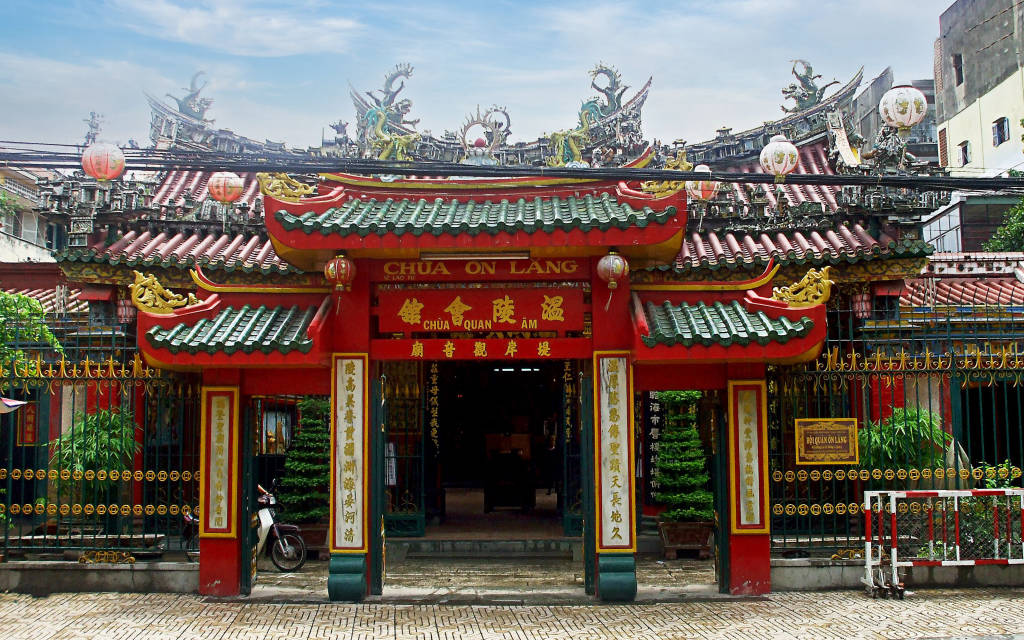1. Introduction to Quan Am Pagoda – On Lang Assembly Hall
Quan Am Pagoda – On Lang Assembly Hall, located at 12 Lao Tu Street in District 5, Ho Chi Minh City, is an ancient temple rich in the cultural and spiritual heritage of the Chinese community. It is not only a renowned spiritual destination but also a notable architectural relic nestled in the heart of the city.
Also known as Quan Am Pagoda On Lang Assembly Hall, or more commonly referred to by locals as Mother Quan Am Temple in District 5, this sacred site welcomes thousands of Buddhist pilgrims every year thanks to its serene architecture and tranquil atmosphere.
2. On Lang Assembly Hall – A Cultural Heritage of the Hoa People
2.1. History and Name Origin
In the late 17th century, the Hoa community from Quanzhou (Fujian province, China) migrated to the Saigon – Cho Lon area. Despite initial hardships, they built On Lang Assembly Hall in 1740 to worship Thien Hau Holy Mother, the protector of seafarers and merchants.
The name "On Lang" implies warmth and comfort, referencing their hometown of Quanzhou. In addition to Thien Hau, the hall also worships Guan Yin Bodhisattva, which is why it's often called Quan Am Pagoda, Quan Am Pagoda Saigon, or Quan Am Pagoda Ho Chi Minh City—a familiar spiritual site among locals when it comes to temples in District 5.
2.2. Architecture and Worship Spaces
Upon entering On Lang Assembly Hall, visitors are immediately impressed by its striking Chinese temple architecture. Covering 1,800 m², the hall features a spacious layout with harmonious altars that emphasize antiquity and create a solemn and peaceful space representative of the famous Quan Am Pagoda on Lao Tu Street.
The gently curving tube-tiled roofs, intricate ceramic statues, and detailed carvings of mythical creatures like phoenixes and qilins are all hallmarks of traditional Fujian-style design. This is truly an architectural masterpiece and a must-visit for lovers of heritage and fine craftsmanship.
The main sanctuary is dedicated to Thien Hau Holy Mother, along with Phuoc Duc Chanh Than and Ba Chua Thai Sinh, to whom worshippers pray for peace and prosperity. The rear sanctuary houses Guan Yin Bodhisattva and important deities such as Guan Yu, Bao Gong, Thanh Hoang, and Tuong Dan Lao Gia.
Other popular folk deities are also honored here, including Sun Wukong, Wen Chang Di Jun, the 18 Arhats, Mother Earth Goddess, and Heavenly Father.
A major architectural highlight is the open-air courtyard (skylight), which offers a quiet, refreshing ambiance. Exquisite bas-reliefs and gold-lacquered calligraphy panels enhance the temple’s grandeur and sanctity.
Notably, a large bronze bell cast in 1825 bearing the inscription "Dao Quang Yi You Year" is a precious artifact preserved at the hall, reflecting the cultural and historical values of the Qing dynasty.
3. The Releasing Pond – Feng Shui and Tranquility
Directly across from the hall on Lao Tu Street in District 5 lies a releasing pond built in 1809. Despite being in the bustling Cho Lon area, this pond retains a peaceful atmosphere and is a great spot to relax after visiting Quan Am Pagoda nearby.
According to Feng Shui, having a pond or lake in front of a temple helps harmonize energy and bless the sacred space. Thus, the management board constructed the pond in 1809 to enhance the spiritual aura of the temple.
Though located in a lively part of the city, the pond adds a touch of nature and serenity to the urban landscape—offering visitors a chance to rest, breathe fresh air, and immerse themselves in the temple’s tranquil setting.
4. Festivals and Traditional Customs
Every year on the 19th of the 2nd, 6th, and 11th lunar months, Quan Am Pagoda in District 5 holds the Guan Yin Festival, attracting crowds of worshippers and visitors seeking peace.
In particular, during Jing Zhe (March 5–6 Gregorian calendar), the temple hosts the unique "beating petty person" ritual—a folk practice meant to drive away bad luck and welcome fortune. This rare ceremony makes "Quan Am Pagoda District 5 beat petty person" a curious search trend.
5. Reviews and Images of On Lang Assembly Hall
Many visitors look for reviews of On Lang Assembly Hall before their trip. Most are impressed by the ancient ambiance, distinctive architecture, and spiritual atmosphere.
Some even share photos of On Lang Assembly Hall as a vivid testament to a sacred landmark amidst a modern metropolis.
6. Visitor Information
If you're searching for Quan Am Pagoda in District 5 or On Lang Pagoda District 5, head to:
Address: No. 12 Lao Tu Street, Ward 11, District 5, Ho Chi Minh City, Vietnam
Opening hours: 6:00 AM to 5:00 PM daily
Visitor note: Dress modestly, maintain silence, and help keep the temple clean when entering for worship.
7. Suggested Nearby Attractions
After visiting On Lang Assembly Hall – Quan Am Pagoda, consider exploring these nearby highlights:
Luong Nhu Hoc Lantern Street: A dazzling spectacle of color, especially during Mid-Autumn Festival
 Register
RegisterSign in Travel Agent
Sign in Supplier
Sign in Affiliate
Sign in Guru













 Số 12 Đường Lão Tử, phường 11, Quận 5, Tp. Hồ Chí Minh, Việt Nam
Số 12 Đường Lão Tử, phường 11, Quận 5, Tp. Hồ Chí Minh, Việt Nam